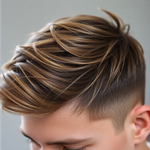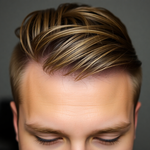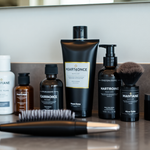
Color‑Code Your Closet: Semi‑Permanent Hair Color Tips for a Sustainable Men's Capsule Wardrobe
23 August 2025
Share
Introduction
Struggling to look sharp without buying more clothes? Color‑coding your closet—down to your hair—makes dressing faster and smarter. Using semi‑permanent hair color to harmonize with a men’s capsule wardrobe gives you fresh style with minimal commitment, fewer chemicals, and less wardrobe churn. Read on for a practical, sustainable game plan you can start this week.
Semi‑Permanent Hair Color: Why It’s Right for Your Capsule Wardrobe
Semi‑permanent hair color sits between a rinse and a dye: it deposits pigment on the hair surface, fades gradually, and doesn’t require harsh lifting agents. For a capsule wardrobe—where each piece must pull its weight—this approach lets you tweak tone, refresh contrast, and fine‑tune your overall palette without committing to long-term color maintenance.
The Big Benefits: Style, Sustainability, Simplicity
- Less decision fatigue: Matching hair tone to core clothing colors reduces outfit clashes and makes mornings quicker.
- Lower environmental impact: Fewer full-apparition dye sessions and intentional color choices mean less product use and waste.
- Gentler on hair: Semi‑permanent options are often ammonia‑free and lower in peroxide, preserving hair health.
- Cost effective: Space out full-color salon visits and use color-depositing conditioners between applications.
Audit Your Wardrobe First: Find Your Core Palette
Don’t pick a hair tone in a vacuum. Do a quick 10‑minute audit:
- Lay out 8–12 pieces you wear most often (jackets, shirts, pants, shoes).
- Identify 2–3 dominant base colors (e.g., navy, charcoal, olive) and 1 accent (e.g., rust, burgundy).
- Note fabric textures—matte wool behaves differently than glossy leather in how it contrasts with hair.
Result: a practical palette to guide your color choices and keep your capsule wardrobe cohesive.
Matching Hair Tones to Popular Capsule Palettes
Below are palette pairings you can adopt immediately. These combinations are forgiving across skin tones and work well with semi‑permanent color's subtler effect.
- Modern Minimalist (navy, charcoal, white): choose cool brown‑black or ash brown rinses to keep contrast low and polished.
- Earthy Casual (olive, tan, cream): warm chestnut or honey brown glosses complement natural tones and textures.
- Smart Casual (navy, grey, burgundy accent): neutral brown with a seasonal burgundy glaze gives energy without overpowering.
- Urban Monochrome (black, stone, steel): blue‑black or soft noir tints sharpen the silhouette for night looks.
How to Choose a Semi‑Permanent Formula
Look for labels and features that support both hair health and sustainability:
- Ammonia‑free and low‑peroxide formulations.
- Added conditioners or oils (argan, coconut) to counteract drying effects.
- Concentrated color‑depositing conditioners for gradual refreshes.
- Brands with recyclable packaging or clear sustainability claims.
At‑Home Application: A Safe 8‑Step Routine
Doing color at home saves money and gives you control. Follow these steps for predictable results:
- Read instructions and perform a patch test 48 hours before to check for allergies.
- Do a strand test on an inconspicuous section to confirm payoff and timing.
- Wash hair 24–48 hours before application; slightly oily roots help protect the scalp.
- Protect skin and clothes with a towel and petroleum‑free barrier cream along the hairline.
- Apply color to dry hair for denser deposition; mid‑length to ends for tone refresh, roots for coverage blends.
- Follow the recommended processing time—no more; semi‑permanent can over‑deposit if left too long.
- Rinse with cool water until runs clear and apply the included conditioner.
- Use a color‑safe, sulfate‑free shampoo and a color‑depositing conditioner on rotation.
Salon vs Home: When to Get a Pro
Some situations benefit from a stylist:
- If you want multi‑dimensional tones or subtle lowlights/highlights.
- If you’re changing from a very light or previously bleached base.
- If you want professional blending for receding hairlines or salt‑and‑pepper coverage.
Otherwise, semi‑permanent products are designed for easy at‑home use—perfect for men building a simple, sustainable grooming routine.
Maintenance That Respects Your Time and the Planet
Maintenance is where sustainability shows up. Keep color lasting longer while using less product:
- Space full applications to 6–8 weeks; use color‑depositing conditioners weekly to stretch time between dyes.
- Wash hair less often—2–3 times a week—and use dry shampoo when you need a quick refresh.
- Rinse with cool water to retain pigment and reduce energy use in hot showers.
- Choose multi‑use products (2‑in‑1 conditioners with tint) to reduce waste and packaging.
Dealing with Fade, Roots, and Transitioning Colors
Fading is expected and useful: it makes transitions gentle.
- For root contrast, apply semi‑permanent only to mid‑lengths and ends for a sunkissed effect.
- To darken gradually, layer a neutral brown rinse every 4–6 weeks instead of a single strong session.
- Switching from warm to cool tones? Use a clarifying wash first, then a cool deposit to neutralize remaining warmth.
Tips for Different Hair Types and Skin Tones
Men aged 18–45 come with diverse hair textures and skin tones. Here’s how to make color work for you:
- Curly/coily hair: use creamier formulas and deep‑conditioning masks to keep moisture locked in.
- Fine hair: choose lighter washes and avoid heavy oils that can weigh hair down.
- Darker skin tones: warmer bronzy tones can complement melanin beautifully—try subtle copper or chestnut glazes.
- Lighter skin tones: ash and cool brown tones create refined contrast without appearing harsh.
Styling to Enhance Your Color‑Coded Look
Small styling choices amplify your coordinated aesthetic:
- Use matte finish products to keep focus on silhouette and color rather than shine.
- A well‑fitted jacket in your core palette (for example, a Menll.com outerwear piece) ties the whole look together—see Menll.com’s outerwear collection for example pieces: Menll.com Outerwear.
- Swap shoes seasonally—like Menll.com’s EcoSneak Casual Shoes—for an accent that complements your hair tone: EcoSneak.
Products to Consider (Eco‑Minded Picks)
Look for these product types when building a sustainable grooming kit:
- Ammonia‑free semi‑permanent dyes and concentrated conditioners.
- Color‑depositing leave‑ins (one pump during shower, leave on for 2–5 minutes).
- Biodegradable wipes and refillable bottles for daily grooming products.
Safety and Ingredient Awareness
Always read labels. If you have scalp sensitivities, do a patch test. For general safety tips and allergy guidance, trusted sources like WebMD explain common dye risks and testing protocols: WebMD: Dyeing Hair Safely.
Case Studies: Real Guys, Practical Results
These short scenarios show how modest color shifts can yield outsized benefits.
- Tyler, 26 — Young Professional: Navy‑heavy wardrobe + ash brown rinse = sharper client meetings and fewer outfit changes. Spaced rinses let him avoid monthly salon trips.
- Marcus, 33 — Creative Freelancer: Olive and camel staples + chestnut glaze = warmer images in photos and fewer wardrobe experiments for shoots.
- Owen, 42 — Dad & Founder: Grey salt‑and‑pepper managed with a soft brown tint for a rested, intentional look that works with his neutral capsule.
Common Mistakes and How to Avoid Them
- Going too bold too fast: start subtle—semi‑permanent is forgiving, but extreme shifts are harder to reverse.
- Ignoring wardrobe colors: color first, then buy; don’t pick clothes to chase a temporary dye.
- Neglecting maintenance: short‑lived results often come from using harsh shampoos or overwashing.
Measuring the Impact: Less Waste, More Use
One of the often overlooked wins of color‑coding is reduced consumption. A synchronized capsule and grooming routine cuts impulse buys and extends the functional life of wardrobe pieces. Small changes—less frequent salon visits, concentrated products—add up to measurable reductions in waste and cost over a year.
FAQ — Quick Answers
- How long does semi‑permanent hair color last? Typically 4–8 weeks depending on wash frequency and exposure.
- Is it safe for sensitive scalps? Perform a patch test; choose ammonia‑free formulas and consult a pro if you have a history of reactions.
- Will it cover grey? Semi‑permanent can blend greys effectively but may not fully cover very dense grey growth—consider targeted root applications.
Final Checklist Before You Start
- Audit your capsule wardrobe (2–3 base colors + 1 accent).
- Pick a semi‑permanent tone that harmonizes with your base palette.
- Buy a color‑depositing conditioner for between‑dye refreshes.
- Plan a 6–8 week cadence for full applications; use spot or mid‑length touches as needed.
Conclusion
Color‑coding your closet and using semi‑permanent hair color is a practical, masculine, and sustainable way to upgrade your image while buying less. It simplifies decisions, reduces waste, and keeps your style intentional. Try a subtle glaze this season and notice how it streamlines your choices—less time thinking, more time living well.
Call to Action
Which palette will you try first? Drop your pick in the comments and explore Menll.com for capsule staples that match your new hair tone.
Prev post

Semi-Permanent Hair Color: A Color-Led System to Simplify and Sustain Your Men's Capsule Wardrobe
Updated on 26 August 2025
Next post

Cut Decision Fatigue: How Semi‑Permanent Hair Color Pairs with a Minimalist, Sustainable Men's Wardrobe
Updated on 23 August 2025





